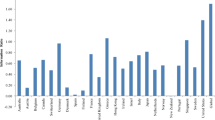Abstract
This paper examines whether book-to-market sorted portfolios exhibit an asymmetric response to changes in economic conditions over the business cycle. It is initially shown that a simple strategy of holding a high book-to-market portfolio produces a greater cumulative excess return over a low book-to-market portfolio, but that most of this differential, although not all, can be explained by changes in macroeconomic conditions. Further results show that portfolio rates of return are indeed more responsive to changes in interest rates and money supply during a contractionary period, and that this responsiveness is typical for high book-to-market portfolios. Further, the average level of volatility is shown to be higher for high book-to-market portfolios, and such portfolios exhibit a greater responsiveness to shocks and changes in economic output. Evidence is reported, however, that a switching strategy can outperform a value strategy which, if it were to persist, would indeed cast doubt on the stability and continued existence of a value premium.
Similar content being viewed by others
Author information
Authors and Affiliations
Rights and permissions
About this article
Cite this article
Black, A., McMillan, D. Value and growth stocks and cyclical asymmetries. J Asset Manag 6, 104–116 (2005). https://doi.org/10.1057/palgrave.jam.2240169
Received:
Published:
Issue Date:
DOI: https://doi.org/10.1057/palgrave.jam.2240169




